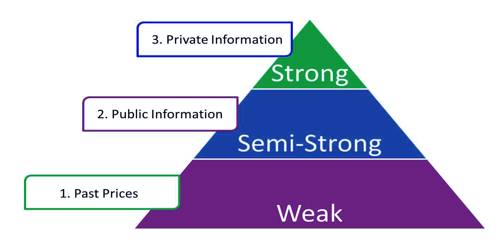Market efficiency concerns the extent to which market prices incorporate available information. Investors and academics have a wide range of viewpoints on how efficient the market actually is, as reflected in the strong, semi-strong and weak versions of the EMH.
The efficient-market hypothesis (EMH) asserts that financial markets are “informationally efficient.” In consequence of this, one cannot consistently achieve returns in excess of average market returns on a risk-adjusted basis, given the information available at the time the investment is made.
The reaction of stock price to new information in efficient and inefficient markets. There are three major versions of the hypothesis: weak, semi-strong, and strong.
- The weak-form EMH claims that prices on traded assets (e.g., stocks, bonds, or property) already reflect all past publicly available information.
- The semi-strong form EMH claims both that prices reflect all publicly available information and that prices instantly change to reflect new public information.
- The strong-form EMH additionally claims that prices- instantly reflect even hidden or “insider” information.

(a) Weak-form efficiency – In weak-form efficiency, future prices cannot be predicted by analyzing prices from the past. Excess returns cannot be earned in the long run by using investment strategies based on historical share prices or other historical data. Technical analysis techniques will not be able to consistently produce excess returns, though some forms of fundamental analysis May still provides excess returns. Share prices exhibit no serial dependencies, meaning that there are no “patterns” to asset prices. This implies that future price movements are determined entirely by information not contained in the price series. Hence, prices must follow a random walk. This “soft” EMH does not require that prices remain at or near equilibrium, but only that market participants are not able to systematically profit from market “inefficiencies. ” However, while EMH predicts that all price movement (in the absence of change in fundamental information) is random (i.e., non-trending), many studies have shown a marked tendency for the stock markets to trend over time periods of weeks or longer and that, moreover, there is a positive correlation between degree of trending and length of time period studied (but note that long time periods, the trending is sinusoidal in appearance).
(b) Semi-Strong form Efficiency: Under semi-strong form efficiency, current market price reflected all past price data and publicly available data.
(c) Strong form Efficiency: Under strong form efficiency current market price reflects all past price data and both public and private information.
















